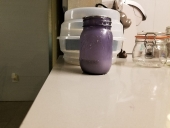We grow most of our own food and have both "meat" and dual purpose chickens. The "meat" chickens are generally the Cornish Cross birds and we butcher at 9 weeks. We've never once had a spontaneous death that people speak of. We raise these birds separately from the regular flock -- they are in a big tractor arrangement and I've been doing this for more than 25 years. Yeah, before Salatin came to the urban-crowd.

The chicken tractor is moved daily so they get fresh grassy greens to pick at and we keep them in a tractor to confine them somewhat while also utilizing the benefits with a fresh daily grass 'floor'. Generally, we have either 25 or 30 Cornish at a time, depending upon the order we place. We feed the Cornish a 19% protein organic feed and supplement with hand-picked forage and garden veggies. When we butcher, we have a full weekend. We butcher half of the flock per day, and we skin them to save time and energy. We don't eat the skin anyway.
Our dual purpose chickens are Barred Rock, Astralorp, Orpington, Wyandotte, and Sussex. We have a flock of 24 (they're 12 months old) and this year, 1 Speckled Sussex rooster. We are incubating a few eggs here and there to perpetuate the flock -- they'll be mixed since we only have the one rooster. Over the years, the Astralorp and Orpingtons will lay year round if we provide a bit of supplemental light (Zone 7, north Virginia area). This is a desirable trait for us. Although we do cull and butcher the dual purpose chickens, the finished bird (the young roo) is generally between 2-3 pounds instead of the 7-8 pound dressed Cornish Cross. Last year we opted for a new breed, the Silver Laced Wyandotte and will cull them as we find they're a bit territorial and not as productive or docile as the other breeds are. Hands down, the Rock, Orpington, and Astralorp are our favorite dual purpose birds and they have also weighed out the best as dual purpose upon butchering.
In my opinion, the only way to cook an older bird is by slow cooking or pressure cooking, ground up, and fed to our dogs.
As for the commercial poultry business -- we're not far from a number of processing plants so we see the truck traffic once in a while. Most transported birds are dead while in transit to the slaughterhouse. Disgusting.




 The chicken tractor is moved daily so they get fresh grassy greens to pick at and we keep them in a tractor to confine them somewhat while also utilizing the benefits with a fresh daily grass 'floor'. Generally, we have either 25 or 30 Cornish at a time, depending upon the order we place. We feed the Cornish a 19% protein organic feed and supplement with hand-picked forage and garden veggies. When we butcher, we have a full weekend. We butcher half of the flock per day, and we skin them to save time and energy. We don't eat the skin anyway.
The chicken tractor is moved daily so they get fresh grassy greens to pick at and we keep them in a tractor to confine them somewhat while also utilizing the benefits with a fresh daily grass 'floor'. Generally, we have either 25 or 30 Cornish at a time, depending upon the order we place. We feed the Cornish a 19% protein organic feed and supplement with hand-picked forage and garden veggies. When we butcher, we have a full weekend. We butcher half of the flock per day, and we skin them to save time and energy. We don't eat the skin anyway.
